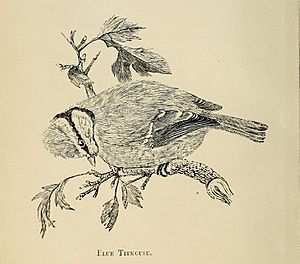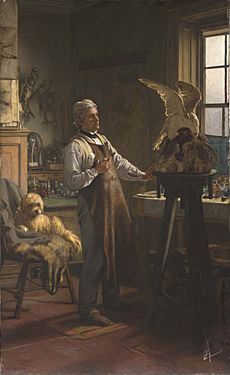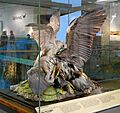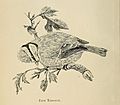John Hancock (ornithologist) facts for kids
Quick facts for kids
John Hancock
|
|
|---|---|

John Hancock in 1874, photographed by Joseph W. Swan
|
|
| Born | 24 February 1808 |
| Died | 11 October 1890 (aged 82) St Mary's Terrace, Newcastle upon Tyne, UK.
|
| Occupation | Ornithologist |
| Years active | 1829–1880s |
| Known for | Ornithological work, including taxidermy, research, art and writing |
|
Notable work
|
The Struggle with the Quarry, 1851 |
John Hancock (born February 24, 1808 – died October 11, 1890) was a British naturalist and ornithologist. He was also a skilled taxidermist and landscape architect.
Hancock lived during a time when taxidermy was very popular. People loved to display mounted animals in their homes. John Hancock is often called the father of modern taxidermy. He created very dramatic and lifelike animal displays.
One of his most famous works was called "Struggle with the Quarry". It showed a falcon attacking a heron that was holding an eel. This amazing display was a big hit at the 1851 Great Exhibition in London. The exhibition was held at the famous Crystal Palace.
Early Life and Work
John Hancock was born in Newcastle upon Tyne, England. His father, John Hancock Sr., owned a business that sold saddles and hardware. After his father passed away in 1812, John and his family moved to Windmill Hills.
John and his brother, Albany Hancock, loved nature from a young age. Their father had many books about natural history. John also learned to draw at a school run by Miss Anna Prowitt. He also studied mathematics.
The Hancock brothers and their friends formed a small group of naturalists. They would travel to nearby places in the summer to study nature. John Hancock was one of the first to notice the differences between two types of swans: the whooper swan and Bewick's swan. He learned how to do taxidermy from Richard Wingate.
John Hancock traveled a lot to study nature. In 1833, he went to Norway with fellow naturalists William C. Hewitson and Benjamin Johnson. Later, in 1845, he visited Switzerland with Hewitson.
Hancock was also a talented artist. In the 1850s, he created many prints of his taxidermy displays. His work at the 1851 Great Exhibition was highly praised for its artistic quality. He also taught and mentored Allan Brooks, a famous bird painter.
Art and Publications
John Hancock learned how to engrave and create lithographs. He used these skills to make several illustrated books. In 1863, he published a book with drawings of his bird displays from the 1851 exhibition.
In 1874, Hancock published his important book, Catalogue of the Birds of Northumberland and Durham. Experts like Professor Alfred Newton praised his work for being very accurate.
Hancock also helped edit a 1847 edition of Birds by Thomas Bewick. He even designed a plan for the Town Moor in Newcastle upon Tyne in 1868, but only part of it was built.
The Hancock Museum
The Hancock Museum in Newcastle upon Tyne is named after John and Albany Hancock. Both brothers played a big part in getting the museum built. They wanted a place to keep important collections of natural history.
After his brother Albany died in 1873, John Hancock suggested building a new, larger museum. He convinced Colonel John Joicey to buy land for the museum. The new museum opened in 1884. John Hancock was in charge of organizing many of the displays.
The museum has many specimens collected by the Hancock brothers. John Hancock also prepared flat skins for the collection. He even received specimens from far-off places like India.
One special item in the museum is a red-necked nightjar. It is believed to be the first one ever found in Britain. John Hancock was very careful with his records. He even noted when information about a specimen's location was missing. He was also the first to record the breeding of the black redstart bird in 1845.
After John Hancock passed away in 1890, the museum was named the Hancock Museum in his honor.
Images for kids
See also
In Spanish: John Hancock (naturalista) para niños










